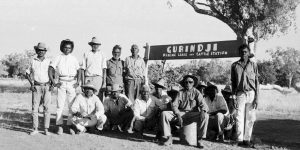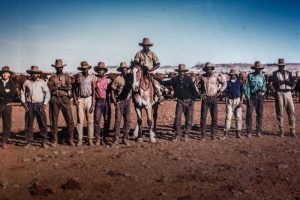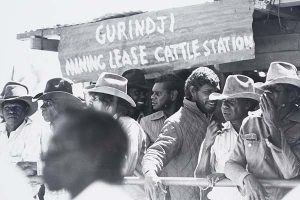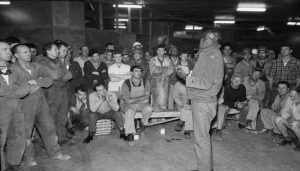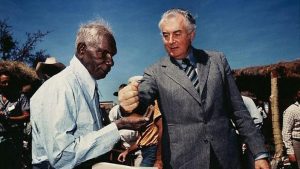The following article, written by Chloe Koffman was first posted by The Tribune. It looks back to an inspirational struggfle which linked Australis’s indigenous workers with Australian labour movement and the key role played by the Australian Communist Party and on te winning of land rights by the Guirindji people.
REMEMBERING WAVE HILL: WHEN AUSTRALIA’S INDIGENOUS FOUGHT BACK
In August 1966, hundreds of indigenous workers walked off the job in Australia’s Northern Territory demanding equal pay. Their strike lasted nine years – and resulted in the return of ancestral lands stolen for generations.
Today marks 55 years since the Wave Hill walk-off, a nine-year strike that forged the bond between trade unions and Indigenous Australians and represents one of the most unique struggles in the history of the Australian labour movement. Though relatively unknown internationally, the strike still remains the longest industrial stoppage in Australian history.
Australia’s violent colonial history is well-known and documented – not only for the bloody European invasion in the 18th century, but for its continued repression and genocide of indigenous people. Subject to foreign disease and indiscriminate murder, the Aboriginal people suffered while their colonisers built entire industries on stolen land. Soon, opal mines in the South, uranium mines in the North and a large number of cattle farms scattered across central Australia came to define the Australian economic landscape. But by the 1960s, the radically diminished indigenous population were an oppressed class of people who were not only denied their basic rights, but the right to live on their own land.
The welfare of indigenous people in the Northern Territory in particular was the archetypal model of colonial repression. Indigenous communities that survived their traditional lands being invaded were often forced to work and live on farms. Fair employment practices were non-existent, and violence against indigenous people was commonplace. Aboriginal women and children were sexually abused, prostitution was rampant and living conditions were squalid, with little water and sanitation. During this time, the Australian state was also creating victims of the Stolen Generations, ripping Aboriginal children from their families and placing them into abusive boarding houses as part of a wider effort to eradicate indigenous culture.
In 1953, all indigenous people were made wards of the Territory and a “scale of wages, rations and conditions” could be exclusively applied to them. This meant European pastoralists and business owners didn’t have to pay Aboriginal people to work but could simply provide them with rations of food, tea and tobacco instead. These scales also forbade employers from paying them more than a set amount in wages and rations in comparison to white employees, who could receive up to 50% more in wages, as well as having access to better living conditions.
Due to the low rates of pay, the threats of violence and oppressive employment and wage laws, indigenous men frequently worked doing hard manual labour on booming cattle stations, on land owned by white settlers. By 1965, the North Australian Workers Union (NAWU) fought to repeal these discriminatory regulations and a change in the law was eventually agreed. However, the agreed changes were delayed from being implemented by three years, sparking anger from indigenous people across the country. After an incredibly hard-fought battle for basic human rights, the delay sparked a wave of anger among Aboriginal communities. And it was on a notoriously brutal cattle station that this anger would be highlighted.
Wave Hill and the Walk-off
At the time, the Wave Hill cattle station was the largest cattle station in the world. It was located on the traditional lands of the Gurindji people, who had lived there for tens of thousands of years before the Europeans violently seized the land in 1854. Once the lands were granted to pastoralists for cattle, the station rapidly expanded. In 1914, Wave Hill was purchased by the Vestey Brothers, an international meat-packing company owned by Baron Samuel Vestey, later known as Lord Vestey.
The Gurindji people resisted the settlers, but their natural sources of food and water, left untouched for millennia, were being damaged by the ever-growing masses of cattle. In addition, violence and murder at the hands of the pastoralists forced Aboriginal people across the Territory onto cattle stations and farms. As late as 1928, atrocities such as the Coniston Massacre demonstrated the state’s open willingness to sanction the murder scores of indigenous people to continue the colonial expansion into central Australia. Left with their traditional lands spoiled by industry and threat of violence from pastoralists, the Gurindji were forced to move on to the station, where they worked for scraps and rations.
The Wave Hill cattle station was a site of particular brutality. Lord Vestey had a long and well-documented history of violating the rights of Aboriginal workers, beyond the repressive laws of the Territory. Vestey Brothers refused to pay Aboriginal workers a wage, meaning that hundreds of Aboriginal men worked on the station for seven days a week for little more than basic sustenance and tobacco. Their housing situation was dire, with workers and their families living in tin ‘humpies’, without any sanitation, furniture, lighting, cooking facilities or running water. Children were often illegally put to work, prostitution for food and clothing was commonplace, and the government benefits given to the Gurindji was stolen from them and transferred directly into the bank accounts of their bosses.
One of the Wave Hill stockmen was Vincent Lingiari, a Gurindji man who had grown up on the station and began working from the age of 12. Lingiari eventually became a lead stockman, but received little financial recompense for his skilled work. Incensed by his working conditions and the degradation of his community’s sacred land, Lingiari began organising for the strike that would change the course of Australian history.
In early 1966, the NAWU began pressuring the Commonwealth Conciliation and Arbitration Commission to remove the discriminatory laws against Aboriginal workers in the Northern Territory and raise the wage to equal that of white workers. Unsurprisingly, this was vehemently opposed by bosses, who claimed that Aboriginal people would not be able to “adjust” to wage equality so quickly, and enrolled the future Governor-General of Australia, John Kerr QC, to represent them. The Commission eventually agreed these changes, but delayed them by three years as a compromise, allowing the pastoralists to earn millions from continued exploitation in the meantime.
However, tensions were at boiling point at Wave Hill. The appalling conditions, coupled with a strike at a nearby station, was fuelling restlessness in the workforce. When they were told they would need to wait three more years for equal wages, enough was enough.
On August 23rd, 1966, 200 stockmen, domestic staff and their families led by Lingiari walked off Wave Hill and set up camp in the dry bed of the Victoria River, near the Wave Hill Welfare Centre (now known as Kalkarindji). Though they were spurred on in opposition to the delay in reforms, the strikers soon added an ambitious clause to their demands – the return of their traditional lands. Lingiari called for the reclamation of the stolen land from Vestey, declaring that “we want to live on our land, our way”.
News of the strike soon spread among the wider labour movement, with trade unionists and Communist Party militants working to raise awareness of the walk-off in the cities and towns. Figures such as the indigenous NAWU organiser Dexter Daniels, indigenous film star Robert Tudawali and the leading Communist NAWU member Brian Manning were key in building the initial support for the Gurindji people. A speaking tour was quickly organised, primarily by indigenous activists, the Communist Party and the Actors Equity union to build solidarity with the strikers.
Lingiari, Daniels, Tudawali and other speakers travelled across the country and gathered massive support from fellow trade unionists. Lingiari was a particular inspiration to many; the world-renowned eye doctor and Communist Party of New Zealand members Fred Hollows donated $500 after hearing him speak, and screened the eyes of Lingiari and other striking stockmen for preventable eye disease.
While the tour raised support and much needed funds, Brian Manning alerted NAWU dockers to the Wave Hill struggle, organising for food and supplies to be taken on the sixteen-hour drive to Kalkarindji using his own truck. In spite of the “moderate” leadership of the NAWU, the militant waterside workers or “wharfies” responded to Manning’s call, agreeing to levy one dollar from every member’s dues to support the Gurindji and keep food going to the strikers. Though trade unions and the labour movement had supported Aboriginal people in industrial disputes before, such as during the 1946 Pilbara Strike, the strikers at Wave Hill commanded widespread solidarity from non-indigenous groups and individuals, vitally sustaining the strike.
As the strike carried on, the support from the wider union movement, student groups and the general public began to grow stronger. The Communist Party of Australia’s newspaper, Tribune, widely publicised the strike, and help to gather large donations from unions and branches across the country. Solidarity demonstrations became commonplace and news of the strike travelled across the globe, with meatworkers at a Vestey Brothers plant in London taking a day of action in support of the strikers.
Another source of support for the Gurindji was the writer Frank Hardy, an active Communist who used media contacts to raise awareness of the strike, organise press conferences and generate massive publicity for the speaking tours, an experience he would later chronicle in his evocative 1968 book detailing the strike, The Unlucky Australians. In 1967, Hardy drafted a petition on behalf of the Gurindji people to the Governor-General, asking for their 600-700 square miles of their land to be returned to them. However, a measly eight square miles was offered in response, located on land that was of no use for Vestey.
That same year, the Gurindji moved their camp to Wattie Creek and established the Daguragu community, located on lands that were closer to indigenous sacred sites – including caves which held the bones of Aboriginals killed by white settlers. This move symbolised the cementing of Gurindji land rights as the pivotal goal of the strike, which Lingiari made clear in his speeches. In response, Vestey attempted to appease strikers with a wage increase and bribes of new houses built near the station. However, the strikers refused; simple offers of a wage increase held no sway with a people who had felt their collective power.
Negotiations and consultations between the Gurindji, the Northern Territory Administration and the federal government had broken down by 1969. The strikers wanted their land, and Vestey Brothers nor the Territory would not budge. The Gurindji stood firm, holding together in the illegal occupation at Daguragu.
A Tall Stranger
In 1972, Gough Whitlam’s government came to power, breaking 23 years of Liberal Party rule with a radical programme of ending conscription and introducing free education, universal healthcare and a legal aid programme.
However, one of Whitlam’s most unique characteristics was his commitment to indigenous land rights and Aboriginal people. He had previously visited the tent embassy on the lawn of parliament set up by Aboriginal activists to protest the refusal to recognise indigenous land rights and had firmly established this as a priority for his government, announcing they would “establish once and for all Aborigines’ rights to land”.
Immediately, the conditions of the strike changed. The Whitlam administration began work to change the standing of Aboriginal land rights by suspending mining exploration licenses and financially supporting incorporated land trusts. In 1975, the Whitlam government began negotiating with Vestey over the Gurindji lands, eventually overturning the Vestey lease and issuing two new leases – one to the Vesteys and one to the Gurindji people.
On the 16th of August 1975, Whitlam travelled to Daguragu and symbolically returned the land to the strikers, pouring the red sand of the Gurindji earth through the hands of Vincent Lingiari and declaring:
Vincent Lingiari, I solemnly hand to you these deeds as proof, in Australian law, that these lands belong to the Gurindji people and I put into your hands part of the earth itself as a sign that this land will be the possession of you and your children forever.
Furthermore, the Whitlam Government had plans to enshrine indigenous land rights into law, following the Woodward Inquiry. However, Whitlam never realised this goal whilst in government, being deposed by Governor-General John Kerr, only months later.
However, the impact of Wave Hill Walk Off had irreversibly changed the struggle of Indigenous Australians and the installed Fraser government passed the Aboriginal Land Rights Act into law in 1976, marking the first law that legally recognised the ownership of land by Aboriginal people.
It remains one of the most remarkable struggles in Australian history, an undeniable catalyst for the modern land rights movement and sparked struggles for indigenous rights that continue until this day. The extraordinary coalition of support broke through the racial barriers that had previously defined the labour movement in Australia, and the organised power of the working class helped push the issue of indigenous rights to the forefront of politics.
The Walk Off has been commemorated widely in Australia and the wider labour movement. Their courage and stamina in the face aristocratic white power remains a source of inspiration to Indigenous Australians in their ongoing fight for their traditional lands. Every year at Kalkarindji, the Gurindji people celebrate victory and commemorate the strike on the anniversary of the walk-off, now known as Freedom Day. Indigenous activists, trade unionists and surviving strikers and their families march side by side, celebrating the bonds of solidarity forged in a unique and harrowing struggle.
But it is perhaps best documented in the iconic Australian song, ‘From Little Things, Big Things Grow’ recorded by Paul Kelly and indigenous singer Kev Carmody of the Murri people:
That was the story of Vincent Lingiari
But this is the story of something much more
How power and privilege cannot move a people
Who know where they stand, and stand in the law.
23.8.23
___________
also see:
Canada is trying to send indigenous water protest to prison – Sam Carliner – Left Voice (USA)

